Abstract
Infection of rat embryo cells with herpes simplex virus type 2 caused undermethylation of host cell DNA synthesized during infection. DNA made prior to infection was not demethylated, but some of its degradation products, including methyl dCMP, were incorporated into viral DNA. The use of mutant virus showed that some viral DNA synthesis appears to be required for the inhibition of methylation. Inhibition of methylation cannot be explained by an absence of DNA methyltransferase as the activity of this enzyme did not change during the early period of infection. Inhibition of host cell DNA methylation may be an important step in the transformation of cells by herpesviruses, and various transformed cell lines tested showed reduced levels of DNA methylation.
Full text
PDF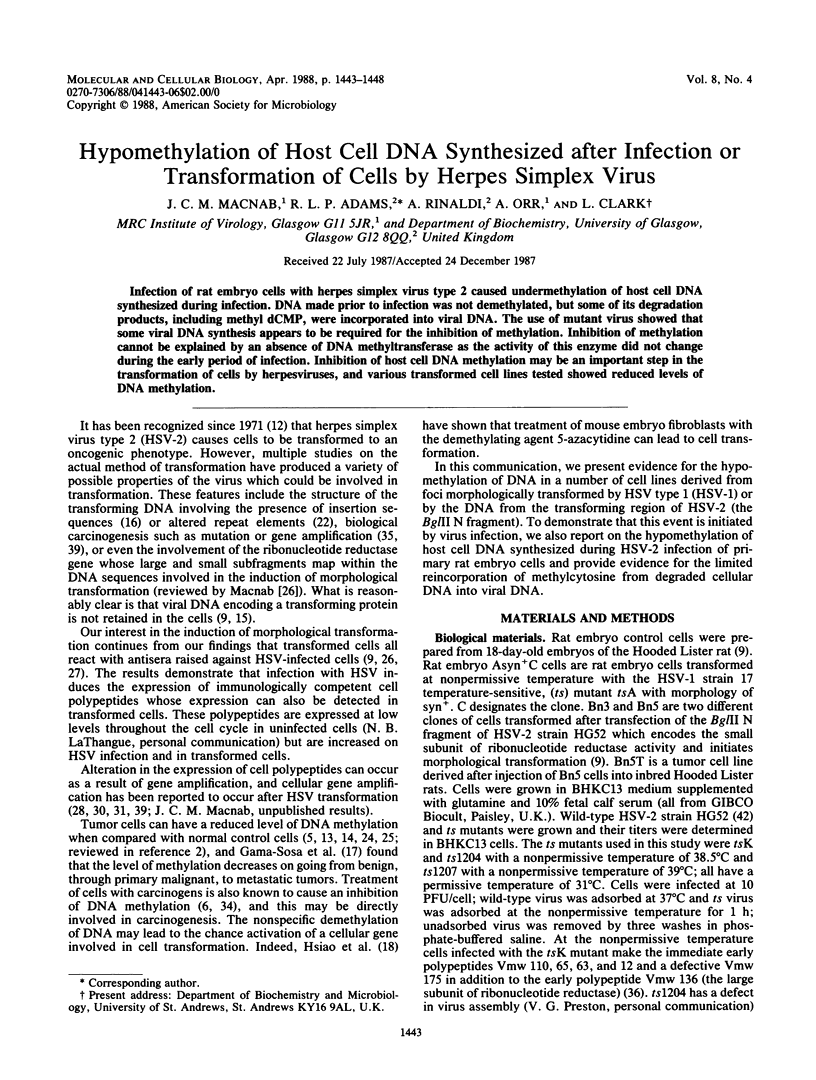
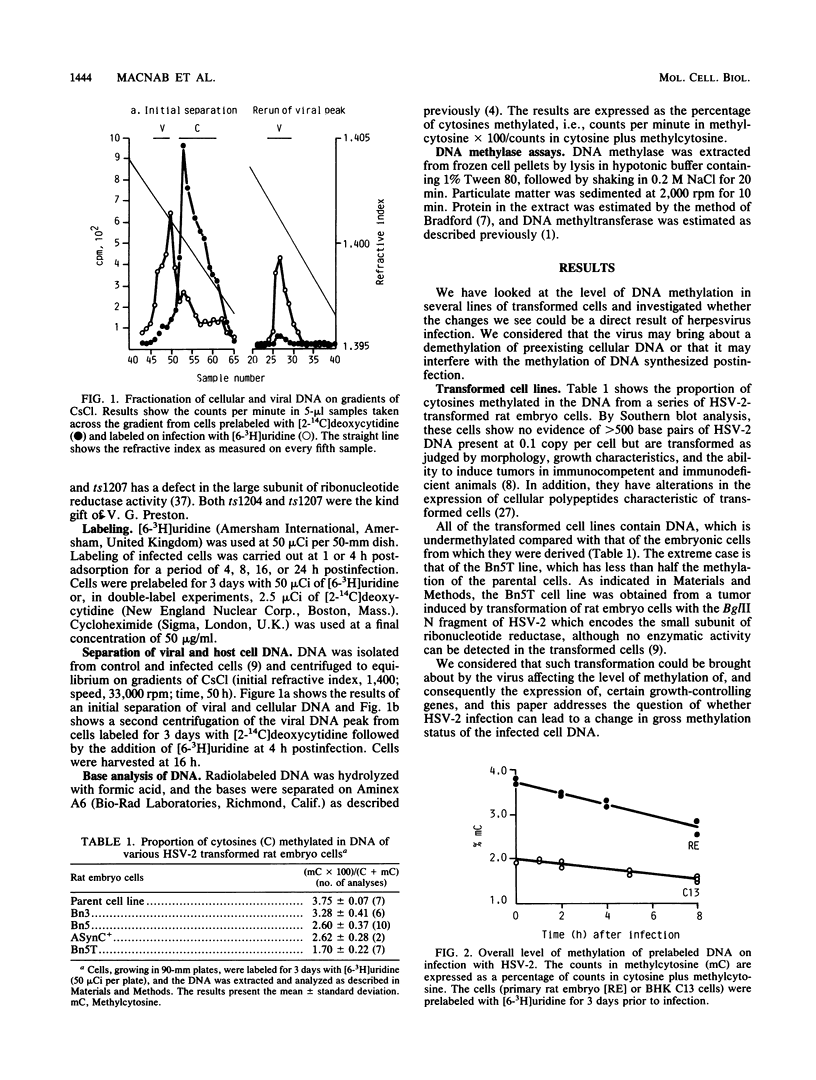
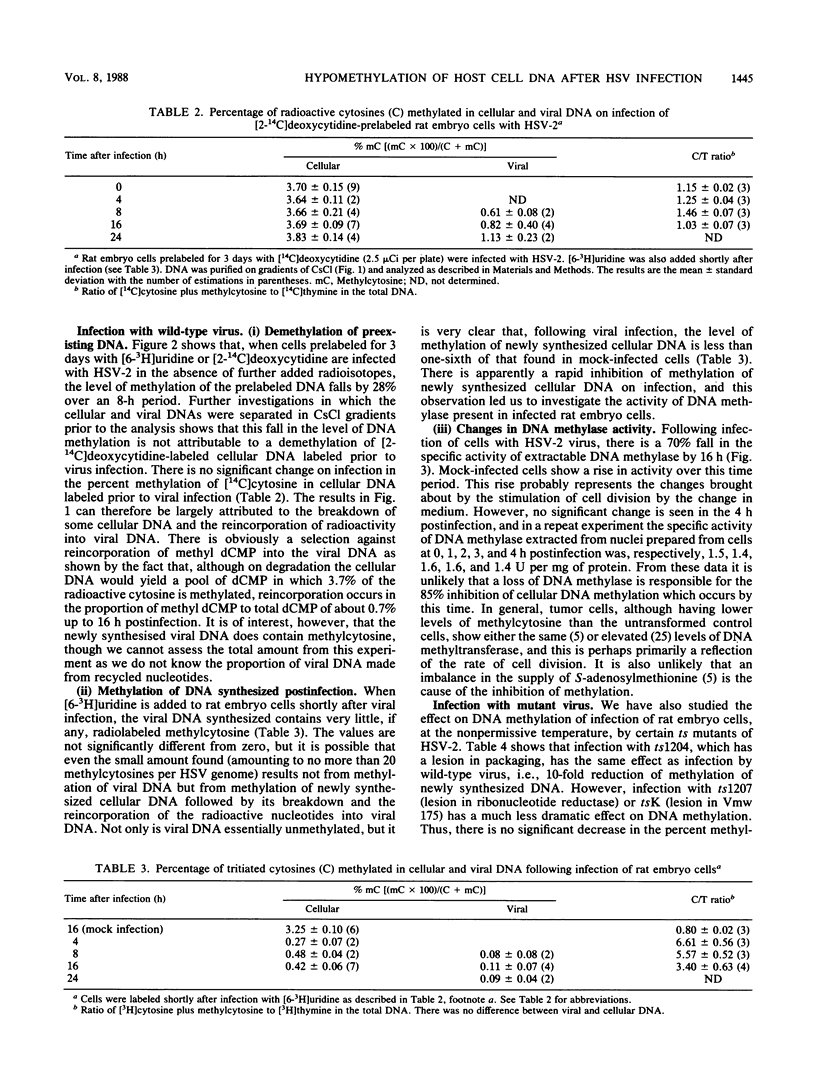

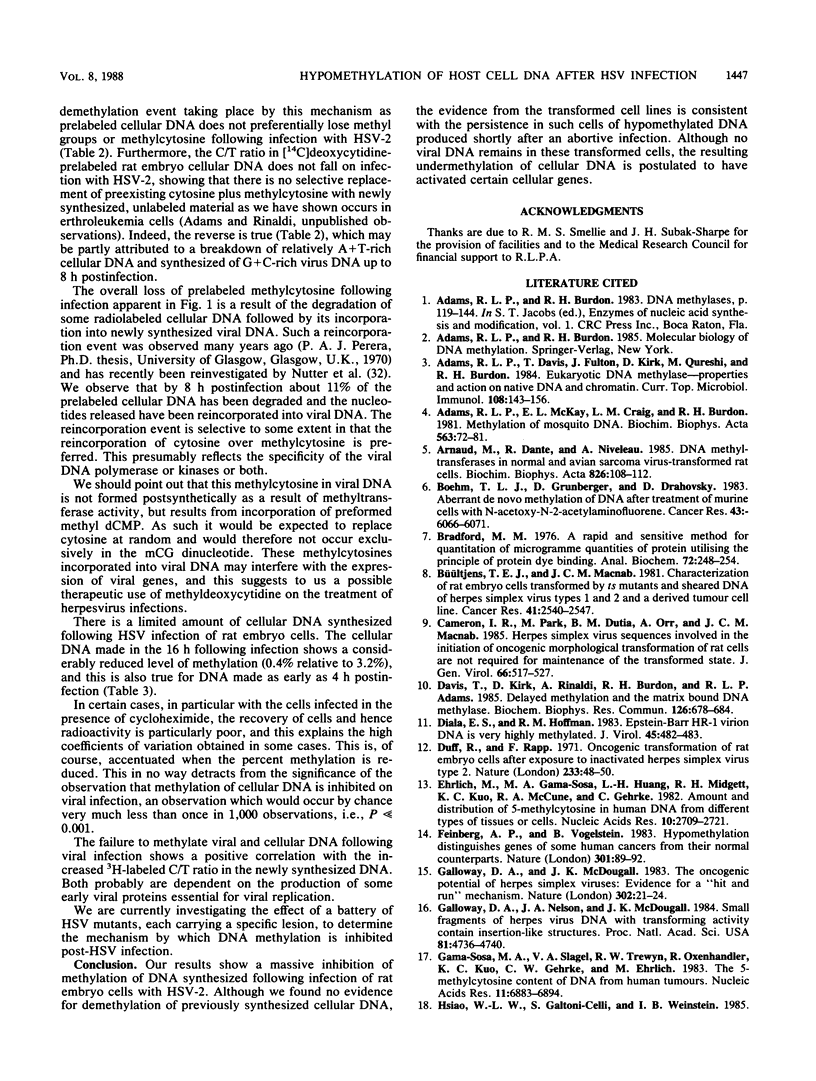
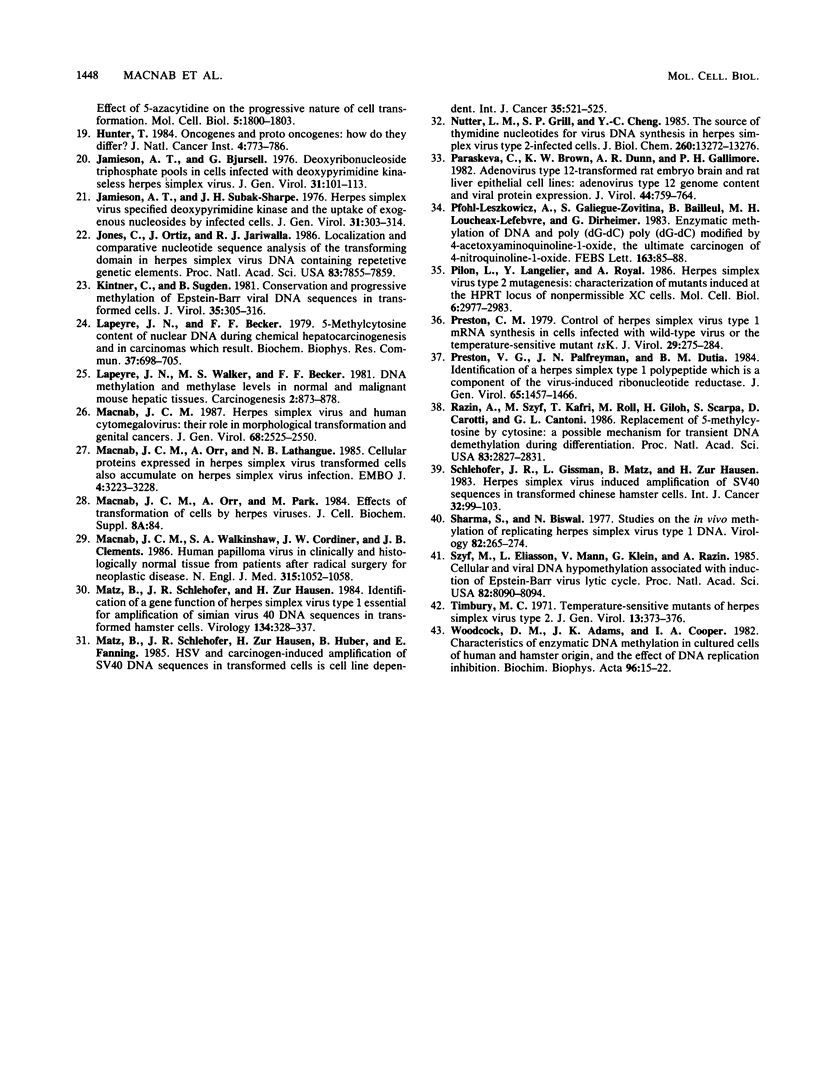
Selected References
These references are in PubMed. This may not be the complete list of references from this article.
- Adams R. L., Davis T., Fulton J., Kirk D., Qureshi M., Burdon R. H. Eukaryotic DNA methylase--properties and action on native DNA and chromatin. Curr Top Microbiol Immunol. 1984;108:142–156. [PubMed] [Google Scholar]
- Adams R. L., McKay E. L., Craig L. M., Burdon R. H. Methylation of mosquito DNA. Biochim Biophys Acta. 1979 Jun 20;563(1):72–81. doi: 10.1016/0005-2787(79)90008-x. [DOI] [PubMed] [Google Scholar]
- Arnaud M., Dante R., Niveleau A. DNA methyltransferases in normal and avian sarcoma virus-transformed rat cells. Quantitation of 5-methyldeoxycytidine in DNA and enzyme kinetics study. Biochim Biophys Acta. 1985 Nov 13;826(2-3):108–112. doi: 10.1016/0167-4781(85)90115-0. [DOI] [PubMed] [Google Scholar]
- Boehm T. L., Grunberger D., Drahovsky D. Aberrant de novo methylation of DNA after treatment of murine cells with N-acetoxy-N-2-acetylaminofluorene. Cancer Res. 1983 Dec;43(12 Pt 1):6066–6071. [PubMed] [Google Scholar]
- Bradford M. M. A rapid and sensitive method for the quantitation of microgram quantities of protein utilizing the principle of protein-dye binding. Anal Biochem. 1976 May 7;72:248–254. doi: 10.1006/abio.1976.9999. [DOI] [PubMed] [Google Scholar]
- Bültjens T. E., Macnab J. C. Characterization of rat embryo cells transformed by ts mutants and sheared DNA of herpes simplex virus types 1 and 2 and a derived tumor cell line. Cancer Res. 1981 Jun;41(6):2540–2547. [PubMed] [Google Scholar]
- Cameron I. R., Park M., Dutia B. M., Orr A., Macnab J. C. Herpes simplex virus sequences involved in the initiation of oncogenic morphological transformation of rat cells are not required for maintenance of the transformed state. J Gen Virol. 1985 Mar;66(Pt 3):517–527. doi: 10.1099/0022-1317-66-3-517. [DOI] [PubMed] [Google Scholar]
- Davis T., Kirk D., Rinaldi A., Burdon R. H., Adams R. L. Delayed methylation and the matrix bound DNA methylase. Biochem Biophys Res Commun. 1985 Jan 31;126(2):678–684. doi: 10.1016/0006-291x(85)90238-4. [DOI] [PubMed] [Google Scholar]
- Diala E. S., Hoffman R. M. Epstein-Barr HR-1 virion DNA is very highly methylated. J Virol. 1983 Jan;45(1):482–483. doi: 10.1128/jvi.45.1.482-483.1983. [DOI] [PMC free article] [PubMed] [Google Scholar]
- Duff R., Rapp F. Oncogenic transformation of hamster cells after exposure to herpes simplex virus type 2. Nat New Biol. 1971 Sep 8;233(36):48–50. doi: 10.1038/newbio233048a0. [DOI] [PubMed] [Google Scholar]
- Ehrlich M., Gama-Sosa M. A., Huang L. H., Midgett R. M., Kuo K. C., McCune R. A., Gehrke C. Amount and distribution of 5-methylcytosine in human DNA from different types of tissues of cells. Nucleic Acids Res. 1982 Apr 24;10(8):2709–2721. doi: 10.1093/nar/10.8.2709. [DOI] [PMC free article] [PubMed] [Google Scholar]
- Feinberg A. P., Vogelstein B. Hypomethylation distinguishes genes of some human cancers from their normal counterparts. Nature. 1983 Jan 6;301(5895):89–92. doi: 10.1038/301089a0. [DOI] [PubMed] [Google Scholar]
- Galloway D. A., McDougall J. K. The oncogenic potential of herpes simplex viruses: evidence for a 'hit-and-run' mechanism. Nature. 1983 Mar 3;302(5903):21–24. doi: 10.1038/302021a0. [DOI] [PubMed] [Google Scholar]
- Galloway D. A., Nelson J. A., McDougall J. K. Small fragments of herpesvirus DNA with transforming activity contain insertion sequence-like structures. Proc Natl Acad Sci U S A. 1984 Aug;81(15):4736–4740. doi: 10.1073/pnas.81.15.4736. [DOI] [PMC free article] [PubMed] [Google Scholar]
- Gama-Sosa M. A., Slagel V. A., Trewyn R. W., Oxenhandler R., Kuo K. C., Gehrke C. W., Ehrlich M. The 5-methylcytosine content of DNA from human tumors. Nucleic Acids Res. 1983 Oct 11;11(19):6883–6894. doi: 10.1093/nar/11.19.6883. [DOI] [PMC free article] [PubMed] [Google Scholar]
- Hunter T. Oncogenes and proto-oncogenes: how do they differ? J Natl Cancer Inst. 1984 Oct;73(4):773–786. [PubMed] [Google Scholar]
- Jamieson A. T., Bjursell G. Deoxyribonucleoside triphosphate pools in herpes simplex type 1 infected cells. J Gen Virol. 1976 Apr;31(1):101–113. doi: 10.1099/0022-1317-31-1-101. [DOI] [PubMed] [Google Scholar]
- Jamieson A. T., Subak-Shape J. H. Herpes simplex virus specified deoxypyrimidine kinase and the uptake of exogenous nucleosides by infected cells. J Gen Virol. 1976 Jun;31(3):303–314. doi: 10.1099/0022-1317-31-3-303. [DOI] [PubMed] [Google Scholar]
- Jones C., Ortiz J., Jariwalla R. J. Localization and comparative nucleotide sequence analysis of the transforming domain in herpes simplex virus DNA containing repetitive genetic elements. Proc Natl Acad Sci U S A. 1986 Oct;83(20):7855–7859. doi: 10.1073/pnas.83.20.7855. [DOI] [PMC free article] [PubMed] [Google Scholar]
- Kintner C., Sugden B. Conservation and progressive methylation of Epstein-Barr viral DNA sequences in transformed cells. J Virol. 1981 Apr;38(1):305–316. doi: 10.1128/jvi.38.1.305-316.1981. [DOI] [PMC free article] [PubMed] [Google Scholar]
- Lapeyre J. N., Becker F. F. 5-Methylcytosine content of nuclear DNA during chemical hepatocarcinogenesis and in carcinomas which result. Biochem Biophys Res Commun. 1979 Apr 13;87(3):698–705. doi: 10.1016/0006-291x(79)92015-1. [DOI] [PubMed] [Google Scholar]
- Lapeyre J. N., Walker M. S., Becker F. F. DNA methylation and methylase levels in normal and malignant mouse hepatic tissues. Carcinogenesis. 1981;2(9):873–878. doi: 10.1093/carcin/2.9.873. [DOI] [PubMed] [Google Scholar]
- Macnab J. C. Herpes simplex virus and human cytomegalovirus: their role in morphological transformation and genital cancers. J Gen Virol. 1987 Oct;68(Pt 10):2525–2550. doi: 10.1099/0022-1317-68-10-2525. [DOI] [PubMed] [Google Scholar]
- Macnab J. C., Orr A., La Thangue N. B. Cellular proteins expressed in herpes simplex virus transformed cells also accumulate on herpes simplex virus infection. EMBO J. 1985 Dec 1;4(12):3223–3228. doi: 10.1002/j.1460-2075.1985.tb04069.x. [DOI] [PMC free article] [PubMed] [Google Scholar]
- Macnab J. C., Walkinshaw S. A., Cordiner J. W., Clements J. B. Human papillomavirus in clinically and histologically normal tissue of patients with genital cancer. N Engl J Med. 1986 Oct 23;315(17):1052–1058. doi: 10.1056/NEJM198610233151703. [DOI] [PubMed] [Google Scholar]
- Matz B., Schlehofer J. R., Zur Hausen H., Huber B., Fanning E. HSV- and chemical carcinogen-induced amplification of SV40 DNA sequences in transformed cells is cell-line-dependent. Int J Cancer. 1985 Apr 15;35(4):521–525. doi: 10.1002/ijc.2910350416. [DOI] [PubMed] [Google Scholar]
- Matz B., Schlehofer J. R., zur Hausen H. Identification of a gene function of herpes simplex virus type 1 essential for amplification of simian virus 40 DNA sequences in transformed hamster cells. Virology. 1984 Apr 30;134(2):328–337. doi: 10.1016/0042-6822(84)90301-5. [DOI] [PubMed] [Google Scholar]
- Nutter L. M., Grill S. P., Cheng Y. C. The sources of thymidine nucleotides for virus DNA synthesis in herpes simplex virus type 2-infected cells. J Biol Chem. 1985 Oct 25;260(24):13272–13275. [PubMed] [Google Scholar]
- Paraskeva C., Brown K. W., Dunn A. R., Gallimore P. H. Adenovirus type 12-transformed rat embryo brain and rat liver epithelial cell lines: adenovirus type 12 genome content and viral protein expression. J Virol. 1982 Nov;44(2):759–764. doi: 10.1128/jvi.44.2.759-764.1982. [DOI] [PMC free article] [PubMed] [Google Scholar]
- Pfohl-Leszkowicz A., Galiegue-Zouitina S., Bailleul B., Loucheux-Lefebvre M. H., Dirheimer G. Enzymatic methylation of DNA and poly(dG-dC) X poly(dG-dC) modified by 4-acetoxyaminoquinoline-1-oxide, the ultimate carcinogen of 4-nitroquinoline-1-oxide. FEBS Lett. 1983 Oct 31;163(1):85–88. doi: 10.1016/0014-5793(83)81169-7. [DOI] [PubMed] [Google Scholar]
- Pilon L., Langelier Y., Royal A. Herpes simplex virus type 2 mutagenesis: characterization of mutants induced at the hprt locus of nonpermissive XC cells. Mol Cell Biol. 1986 Aug;6(8):2977–2983. doi: 10.1128/mcb.6.8.2977. [DOI] [PMC free article] [PubMed] [Google Scholar]
- Preston C. M. Control of herpes simplex virus type 1 mRNA synthesis in cells infected with wild-type virus or the temperature-sensitive mutant tsK. J Virol. 1979 Jan;29(1):275–284. doi: 10.1128/jvi.29.1.275-284.1979. [DOI] [PMC free article] [PubMed] [Google Scholar]
- Preston V. G., Palfreyman J. W., Dutia B. M. Identification of a herpes simplex virus type 1 polypeptide which is a component of the virus-induced ribonucleotide reductase. J Gen Virol. 1984 Sep;65(Pt 9):1457–1466. doi: 10.1099/0022-1317-65-9-1457. [DOI] [PubMed] [Google Scholar]
- Razin A., Szyf M., Kafri T., Roll M., Giloh H., Scarpa S., Carotti D., Cantoni G. L. Replacement of 5-methylcytosine by cytosine: a possible mechanism for transient DNA demethylation during differentiation. Proc Natl Acad Sci U S A. 1986 May;83(9):2827–2831. doi: 10.1073/pnas.83.9.2827. [DOI] [PMC free article] [PubMed] [Google Scholar]
- Schlehofer J. R., Gissmann L., Matz B., zur Hausen H. Herpes simplex virus-induced amplification of SV40 sequences in transformed Chinese hamster embryo cells. Int J Cancer. 1983 Jul 15;32(1):99–103. doi: 10.1002/ijc.2910320116. [DOI] [PubMed] [Google Scholar]
- Sharma S., Biswal N. Studies on the in vivo methylation of replicating herpes simplex virus type 1 DNA. Virology. 1977 Oct 15;82(2):265–274. doi: 10.1016/0042-6822(77)90002-2. [DOI] [PubMed] [Google Scholar]
- Szyf M., Eliasson L., Mann V., Klein G., Razin A. Cellular and viral DNA hypomethylation associated with induction of Epstein-Barr virus lytic cycle. Proc Natl Acad Sci U S A. 1985 Dec;82(23):8090–8094. doi: 10.1073/pnas.82.23.8090. [DOI] [PMC free article] [PubMed] [Google Scholar]
- Timbury M. C. Temperature-sensitive mutants of herpes simplex virus type 2. J Gen Virol. 1971 Nov;13(2):373–376. doi: 10.1099/0022-1317-13-2-373. [DOI] [PubMed] [Google Scholar]
- Woodcock D. M., Adams J. K., Cooper I. A. Characteristics of enzymatic DNA methylation in cultured cells of human and hamster origin, and the effect of DNA replication inhibition. Biochim Biophys Acta. 1982 Jan 26;696(1):15–22. doi: 10.1016/0167-4781(82)90004-5. [DOI] [PubMed] [Google Scholar]


